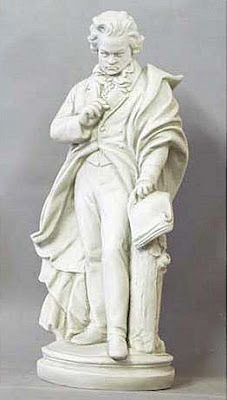Among the teachers Beethoven studied with early on was Joseph Haydn. Beethoven took counterpoint lessons with Haydn but the relationship took a turn for the worse when Haydn suggested that Beethoven add the words 'a pupil of Haydn' on his first compositions to be printed, the Opus 1 piano trios. Haydn possibly offered the suggestion to give the young composer's work the prestige of Haydn's world-wide fame, but Beethoven took it the wrong way and balked at the suggestion. Beethoven later said that he had learned nothing from Haydn when he was his student, but Haydn thought enough of Beethoven to consider taking him along on his second journey to London in 1796. But that didn't happen, and when Haydn made the trip the lessons with Beethoven stopped. For the most part, it looks as though Haydn treated Beethoven well, although he did call him 'the great Mogul'. In any case, Beethoven was never an easy personality to get along with, even in his younger years.
Beethoven and Haydn came to respect each other, with Beethoven considering him an equal to Mozart and Handel. Haydn too respected Beethoven's talent and compositions. And as far as Beethoven not learning anything from Haydn, perhaps he didn't learn a great deal in the formal lessons he took from him, but from Haydn's compositions Beethoven learned much.
The first piano sonatas Beethoven had published were the three sonatas in his Opus 2, all of them dedicated to his old teacher Haydn. The third one in the set, in C Major, is written for a virtuoso and is a good example of Beethoven's piano playing abilities. It is in 4 movements:
I. Allegro con brio - Beethoven opens the piece with a motive in triplet thirds that test the musicality of the performer right off:
What makes this movement unique for the time it was written is that Beethoven uses three instead of the customary two themes in sonata form. After the first theme there is the first secondary theme:
After the statement of the theme Beethoven works his way to the second secondary theme:
This all happens in the exposition of the first movement amid virtuosic passages and key modulations. In the working out of these themes in the development section there are more surprises as Beethoven uses his skill and imagination to keep the listener interested. Beethoven even uses a cadenza towards the end of the movement, something most generally heard in a concerto at the time.
II. Adagio - The slow movements in Beethoven's sonatas are distinctive for their ingenuity and expansion of mood and emotion. This slow movement has moments of serenity juxtaposed with moments of fury, an indication of Beethoven's personal temperament.
III. Scherzo: Allegro - The scherzo of this sonata begins with a theme that is treated contrapuntally, and by way of contrast the trio is a simple minor key melody played in the bass while the right hand scampers about playing arpeggios.
IV. Allegro assai - Beethoven throws a few 'curves' at the listener in this movement. This sonata was written while Haydn was still alive and having a grand success with his second batch of 'London' symphonies. The great Mozart was only 5 years dead. This sonata was written in a grand virtuoso style by Beethoven, but it also contains much that was characteristic and original to Beethoven that were increased in his later compositions.





No comments:
Post a Comment